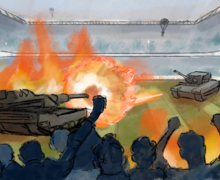School completes first phase of relocation process
Once scattered all around the Syracuse University campus, the David B. Falk College of Sport and Human Dynamics is in the process of moving to one centralized location.
The school is relocating into White and MacNaughton Halls, the former College of Law. The College of Law is now in Dineen Hall, which opened this fall. Falk Dean Diane Lyden Murphy sent a memo to Falk students in December outlining the changes and what they should expect as a result of the move.
The first phase of the move, which has been in the works for several months, was completed just before classes started this semester. As of Jan. 12, the Offices of the Dean, Admissions, Advancement, Falk IT, Departments of Child and Family Studies, Public Health and the School of Social Work are in the new Falk Complex, said Michele Barrett, director of communications for Falk.
Since the move is still ongoing and in between phases, not everything is in one location and the centralized location is still incomplete.
The Nutrition Science and Dietetics program is also temporarily relocated to Sims Hall. It will be moved into the new Falk Complex during the summer and fall of this year. The Office of Student Services is scheduled to move into the Falk Complex in March, while the Department of Sport Management and College Research Center will move in May. Barrett said all of the plans for the move are currently on schedule.
In addition to existing classes and departments, a Nutrition Assessment Laboratory, a ticket sale and call and technology training center for sport management students, a teaching kitchen auditorium and a cafe will be added to the Falk Complex, Barrett said.
“The timetable to move into the new building was purposefully designed to make it smooth and seamless for students,” she said.
There were maps and directories, as well as staff around the new building on the first few days of the semester in order to help students locate their new classes, Barrett said.
The response from students on the first phase of the move has been positive thus far, Barrett said.
“Locating faculty and staff, finding academic offices and computer labs, and learning the layout of a new building takes time,” she said. “But feedback so far has been very positive.”
But Toni Marchand, a junior public health major, said her transition was anything but seamless.
“I honestly didn’t know where I was going or what I was doing. I had to email my adviser and some other people to find out where my classes were,” Marchand said. “I found everything once I knew where I was going, but everything was a little unclear.”
Although the initial move was difficult for Marchand, she agrees that having all of her classes in one place is better than having to travel to different buildings. For example, it allows her to stay in one place all day for most of her classes, she said.
Stephanie Haber, a freshman nutrition science and dietetics major, said that despite efforts from faculty, locating classes on the first day of the semester was challenging as well.
“On my first day of classes I ended up being late with another (student) who was lost just like I was,” Haber said. “I feel like it’s much harder to navigate compared to other colleges on campus.”
While the transition might take time, Barrett said the overall result should be a more convenient and centralized space for students and staff.
“To have a centralized home for classes, collaboration with peers and faculty and quiet study space for starters is something new and very valuable for Falk students,” Barrett said.
Published on January 21, 2015 at 12:01 am
Contact Rachel: rsandler@syr.edu





